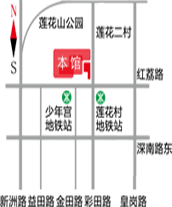- Event Review | Exhibition Opening and Related Academic Activities of "Tracing the Origin of Handwriting - The Road of Guan Shanyue's Sketching from the Perspective of Space and Sky"
Guided by the Shenzhen Municipal Bureau of Culture, Radio, Television, Tourism and Sports, hosted by the Guanshanyue Art Museum in Shenzhen, and co organized by Wuhan University, the exhibition "Tracing the Origin of Handwriting - The Road of Guanshanyue Sketching from the Perspective of Space and Sky" held its opening ceremony on June 5th at the Guanshanyue Art Museum.
The exhibition creatively combines remote sensing satellite data, digital AI technology, and Mr. Guan Shanyue's landscape paintings through the deep integration of cutting-edge technology and classic art, presenting a dialogue between art and science that transcends time and space for the audience. At the opening ceremony, guests from various fields including academia, art, and technology gathered to engage in in-depth discussions on the new paradigm of technology and art integration.
This exhibition is a nominated project for the 2024 National Art Museum Young Curator Support Program of the Ministry of Culture and Tourism, and also the fourth "Digital Humanities Research Exhibition" of Guanshanyue Art Museum. The exhibition will last until July 4th.
Unlock pen and ink password for aerial data
Chen Junyu, the director of Guan Shanyue Art Museum, stated that this exhibition re examines Mr. Guan Shanyue's sketching route in a broader geographical space and historical context through a new perspective of digital humanities research. When we use spatial analysis to trace Mr. Guan Shanyue's life sketches, the geographical information and era imprints hidden between the brush and ink are vividly presented before us. "He emphasized," This interdisciplinary research perspective allows us to have a more three-dimensional and rich understanding of the artist's creative process, and also opens up new possibilities for art history research
Digital art activates the path of sketching
The biggest highlight of the exhibition lies in the deep integration of technology and art, combining remote sensing satellite data, digital AI technology, and traditional landscape paintings to construct a new paradigm for art research.
Through remote sensing images, elevation models, and digital AI technology, the exhibition not only restored Mr. Guan Shanyue's sketching scenes, but also explored the inherent connection between his works and natural landscapes, revealing the spatial expression characteristics of landscape painting within the framework of geological authenticity.
Two digital art installations are particularly eye-catching at the exhibition site. Inspired by Mr. Guan Shanyue's work Drifting with the Sound of Water, Danyan Streaming Shadow · Nine Tunes of Neon Clothes turns the landscape scene of Mount Wuyi into a multimedia light and shadow device. During the audience's walk, it seems that the green landscape of Mount Wuyi overflows from the painting, and the visual transformation of "close and far" is completed in the interweaving of virtual and reality. The TV series' The Thousand layered Curtain of Blue Waves and Sail Shadows' dynamically presents Mr. Guan Shanyue's' Cloud Dragon Lying in the Sea 'and' Cloud Dragon Dancing in China ', simulating the splashing of waves and the rise and fall of tides through animation, vividly showcasing the vastness and layering of the South China Sea. The design of integrating music and painting allows the audience to feel as if they have traveled through time and space, experiencing firsthand what Mr. Guan Shanyue saw while creating in the South China Sea.
Interdisciplinary dialogue to reconstruct the perspective of art history
Associate Professor Liu Yaping from Shandong Academy of Arts and Crafts believes that "this exhibition is a cross disciplinary and innovative visual reconstruction and narrative activity that integrates new technologies into the classic landscape paintings of Guan Shanyue. It not only provides a new perspective for the narrative logic of art history, but also broadens the horizons and fields of art exhibition history, and has important contemporary value and significance
The exhibition also featured a digital art interactive installation created by students from Harbin Institute of Technology (Shenzhen) titled "Preface to the River Gorge: Looking Back, Imaging, and Remote Viewing". Spanning three historical nodes, it integrates history and future, reality and imagination, vividly showcasing the development process and spiritual outlook of the motherland at different stages.
At present, new technologies and media are increasingly involved in artistic creation and exhibition practices, bringing new opportunities and viewing forms to the current presentation of traditional art forms. Since 2019, Guan Shanyue Art Museum has been observing Guan Shanyue's classic landscape paintings from a digital humanities perspective, launching a series of exhibition activities. Through interdisciplinary research methods and digital presentation forms, it has provided new possibilities for contemporary narrative of traditional art. As Liu Yaping said, this exploratory exhibition, in terms of cultural identity, is an effective attempt to construct a knowledge system of Chinese art and develop contemporary exhibition forms of traditional Chinese art styles. Chen Junyu also emphasized that the continuous promotion of digital humanities research by art museums is aimed at activating traditional art resources with the power of technology, allowing classic works to radiate new vitality in the new era context.
Visual Reconstruction: Academic Activity of "Handwriting Traceability"
It is worth mentioning that on the afternoon of June 6, 2025, our museum also held an academic event titled "Visual Reconstruction: Tracing the Origin of Handwriting - The Path of Guan Shanyue Sketching from the Perspective of Space and Sky", further exploring the new possibilities of technology empowering traditional art. The event will start with a keynote speech by Associate Professor Weng Ziyang from the Department of Geographic Information Engineering at the School of Remote Sensing Information Engineering, Wuhan University, titled 'Gazing at the Motherland'. Subsequently, the roundtable invited six experts, including Chen Junyu, Director of Shenzhen Guanshanyue Art Museum, Guan Jian, a full-time painter at Guangdong Academy of Fine Arts and Chairman of Guanshanyue Art Foundation, Liu Yaping, Associate Professor of Humanities and Arts at Shandong Academy of Arts and Crafts, Chen Guohui, Associate Professor of Painting and Arts at Guangzhou Academy of Fine Arts, Le Yang, Professor of Urban Governance and Design at the Hong Kong University of Science and Technology (Guangzhou), and Weng Ziyang, Associate Professor of Geographic Information Engineering at the School of Remote Sensing Information Engineering at Wuhan University, to explore the exhibition from various dimensions.
Experts believe that this exhibition is a typical case that fully utilizes contemporary cutting-edge technology to collide, interact and integrate with landscape painting creation, landscape painting works, and landscape painting performance objects. It has the contemporary value and significance of exploring and constructing visual presentation forms and viewing methods across disciplines and media in the context of visual culture. An exhibition is a complete visual work that attempts to construct a new visual paradigm between artistic classics and contemporary media language, giving Guan Shanyue's classic landscape paintings the meaning of "meta images" and making the exhibition itself self-sufficient and open, thus triggering more thinking and possibilities.
2025-06-13



